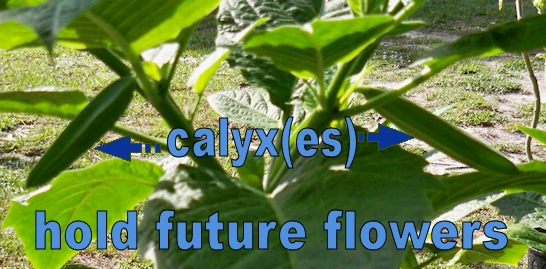Plant Glossary of
Terms
C
Plant Glossary C
Callus: Protective tissue formed by the cambium to aid in healing a wound, particularly in woody plants. A proliferating mass of disorganized, mostly undifferentiated or undeveloped cells.
Callus Culture: The multiplication of callus cells in sterile culture
Calyx:
The sepals of a flower, typically forming a whorl that encloses the petals and forms a protective layer around a flower in bud.
A cuplike cavity or structure, in particular. In the case of brugmansia, they are long, slender 'tubes' that resemble pods. They are hollow at first, and then the young flower will begin to fill it in. When it is ready to open, the lower tip of the calyx will open to release the flower.

Cambium: Layer of growth tissue capable of producing new cells to increase the girth and length of stems and roots. The thin layer of tissue between the wood and the bark of a stem
Capping: A crust forming on the surface of soil or soil mix caused by heavy rain or watering or compaction
Carbohydrate: Any of certain organic compounds composed of elements of carbon, hydrogen, and oxygen, containing sugars, starches, and cellulose.
Carcinogen: Any substance that causes cancer
Catalyst: A substance that promotes the rate of a chemical reaction but which is not itself changed chemically.
Cell: The basic physical unit of living organisms
Cell Culture: The multiplication in vitro of single cells or clumps of cells not organized as tissues, often included in the broad term 'tissue culture'
Cell Suspension Culture: The culture of single cells or clumps of cells suspended in a liquid medium
Centrifuge: A device for spinning test tubes of liquid cultures for the purpose of separating particles, by density or size, by means of centrifugal force.
Also the verb form, to separate particles by means of centrifugal force.
Chimera: A plant that contains tissues of more than one genotype, such as certain plants with variegated foliage.
Chitin: An extract formed by crustaceans and insects, forming an exoskeleton, and used in soil mixes. High in calcium
Chlorophyll: The green pigment that enables plants to capture energy from sunlight and manufacture food. (See also Photosynthesis)
Chlorosis: The absence of green pigments in plantsw due to lack of light, nutrient deficiency, or disease. Chlorotic plants often have a yellowed appearance.
Chromosome: A string og genes contained within a cell nucleus, responsible for transmitting hereditary characteristics
Cleistogamic: Type of self pollinating, often insignificant, flower that remains closed
Clone: A genetically identical group of plants derived from one individual by vegetative propagation or apomixis
Coconut Milk: (Coconut water) The liquid endosperm of coconuts
Coenzyme: An organic substance that activates an enzyme or accelerates its action
Coleoptile: A protective membrance surrounding the primary leaf of grass seedlings. It is noted for its auxin content, as demonstrated by Frits Went's classic experiment
Compound: A substance made up of 2 or more elements chemically combined in fixed proportions
Conductivity: A measure of the ability of water to conduct electricity. The conductivity level indicates the concentration of ions dissolved in water, and thus the purity of the water. It is often measured in units called 'siemens' (S)
Contaminant: Any unwanted microorganisms that appear in tissue culture and overgrow, inhibit, poison or otherwise pollute the desired culture.
Cotyledon: (Seed leaf) First leaf or pair of leaves produced by a seed, frequently different from the true leaves that appear later. Sometimes, cotyledon
leaves are feed leaves, and feed the young seedling until it is established.
Cross: To interbreed (See also Hybrid)
Crown: (1) The upper part of the rootstock where shoots arise, at or just below soil level (2) Branched part of a tree above the trunk (3) Entire rootstock, as in asparagus and rhubarb
Cultivar: A named plant variety in cultivation, not a species, but a man-made, or created through hybridyzing, plant.
Culture: A plant or plant part growing in vitro. Also the verb form, to grow a plant in vitro
Cytokinins: A group of growth hormones that induce bud formation and shoot multiplication and promote cell division and enlargement.
Tags: gardening, plant, and botany definitions, plant glossary c


